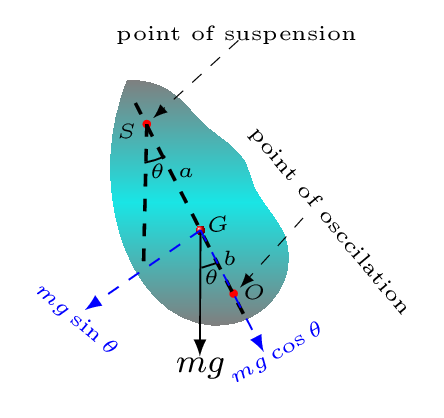Subsection 7.5.3 Compound Pendulum

A compound pendulum consists of a rigid body that oscillates about a horizontal frictionless axis passing through a point \(S\text{.}\) It is also called a physical pendulum. When a body is displaced from its equilibrium position by an angle \(\theta,\) then the restoring torque starts acting on the center of gravity G of the body which is given by
\begin{equation*}
\tau = I \alpha = -mga\sin\theta
\end{equation*}
\begin{equation*}
\text{or,}\quad I\ddot{\theta}=-mga\theta \quad [\text{for small angle approximation}]
\end{equation*}
\begin{equation*}
\text{or,}\quad \ddot{\theta}+\frac{mga}{I}\theta =0
\end{equation*}
\begin{equation*}
\text{or,}\quad \ddot{\theta}+\omega^{2}\theta =0
\end{equation*}
where \(\omega^{2}=\frac{mga}{I} \)
\begin{equation*}
or, \, \omega = \sqrt{\frac{mga}{I}} =\frac{2\pi}{T}
\end{equation*}
\begin{equation*}
\therefore\quad T = \sqrt{\frac{I}{mga}}
\end{equation*}
here,
\begin{equation*}
I = I_{cm}+Ma^{2} = Mk^{2}+Ma^{2}
\end{equation*}
\(k\) is radius of gyration
\begin{equation*}
\therefore\quad T = 2\pi\sqrt{\frac{k^{2}+a^{2}}{ga}}
\end{equation*}
Comparing time period of simple pendulum and compound pendulums we will get -
\begin{equation*}
l=\frac{k^{2}+a^{2}}{a}
\end{equation*}
This is the length of equivalent simple pendulum. If all the mass of a rigid body were concentrated at a point \(O\) [Figure 7.5.7] such that
\begin{equation*}
SO= \frac{k^{2}+a^{2}}{a}
\end{equation*}
then we will get a simple pendulum of same time period. The point \(O\) is called the center of oscillation. Now from
\begin{equation*}
l=\frac{k^{2}+a^{2}}{a},
\end{equation*}
we have -
\begin{equation*}
a^{2}-la+k^{2} =0
\end{equation*}
Which is a quadratic in a, whose roots are
\begin{equation*}
a=\frac{l\pm\sqrt{l^{2}-4k^{2}}}{2}
\end{equation*}
Therefore
\begin{equation*}
a_{1} +a_{2} =l
\end{equation*}
and
\begin{equation*}
a_{1}a_{2}=k^{2}
\end{equation*}
Thus both \(a_{1}\) and \(a_{2}\) are positive. That is there are two positions of the center of suspension and center of oscillation about which the time periods are the same. The distance between two such positions of the centers of suspension, asymmetrically located on either side of C.G, is the length \(l=a+b\) of the simple equivalent pendulum. Thus time period through point \(S\) or \(O\) is same. If the body is supported by an axis through \(G\text{,}\) the time period of oscillation would be infinite.
